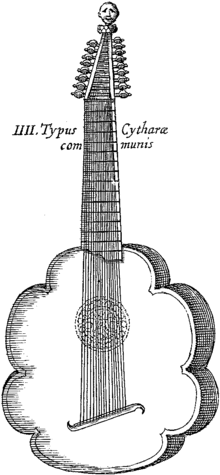Orpheoreon

The Orpheoreon or Orpharion , also Orpheorion , is a plucked instrument from the Renaissance that belongs to the cistern family.
Design and history
The Orpheoreon is a box-necked lute that is similar in shape to the larger Pandora . The metal strings are tuned like the lute and are also struck with the fingers.
The saddle and the bridge run diagonally towards the neck , which increases the scale length (the vibrating string length) from the treble to the bass.
The orpheoreon was probably invented towards the end of the 16th century by the English violin maker John Rose. The name is first handed down in a poem by Michael Drayton from 1590. The instrument is often given in sources of English music around 1600 as an alternative to the lute or Pandora. Even John Dowland published from 1597 songs that are to accompany, among others, the "Orpherian".
The name is derived from the Greek: Orpheo stands for the mythological singer Orpheus (Greek Όρφευς), -reon comes from rhein (ῥεῖν), which means "to flow".
literature
- Donald Gill: The Orpharion and Bandora . In: Galpin Society Journal , Vol. 13, 1960, pp. 14-25
- Ian Harwood, Lyle Nordstrom: Orpharion. In: Grove Music Online, 2001
Web links
- Ian Pittaway: Wired for sound: the bandora and orpharion. Early Music Muse
Individual evidence
- ^ Robin Headlam Wells: Elizabethan Mythologies: Studies in Poetry, Drama, and Music . Cambridge 1994, p. 143
- ^ Roland John Jackson: Performance Practice: A Dictionary-guide for Musicians . New York 2005, p. 32
- ↑ John Dowland: The first Booke of Songes or Ayres of fowre partes with Tableture for the Lute: So made that all the partes, together or either of them seue-rally may be song to the Lute, Orpherian or Viol de gambo. London (printed by Peter Short) 1597.